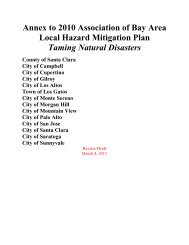Healthy Trails Guidebook - County of Santa Clara
Healthy Trails Guidebook - County of Santa Clara
Healthy Trails Guidebook - County of Santa Clara
Create successful ePaper yourself
Turn your PDF publications into a flip-book with our unique Google optimized e-Paper software.
Plants & Wildlife<br />
Poison Oak<br />
Poison Oak grows abundantly<br />
throughout the park system.<br />
It can grow as a shrub or vine,<br />
scaling the heights <strong>of</strong> trees.<br />
The plant’s oils can produce an<br />
irritating rash after coming in<br />
contact with skin. Leaves are<br />
grouped in three and vary in<br />
color from green, yellow or red, depending on the season. Even leafless<br />
winter stems contain the oils.<br />
• Avoid contact with poison oak. Remember, “Leaves <strong>of</strong> three, let them be.”<br />
• Wear socks and long pants, and do not touch plants while out on the trail.<br />
• Keep pets close — they can transfer oils to you if they play around this<br />
plant.<br />
• If you do come in contact with poison oak,<br />
wash skin immediately with soap and water and<br />
launder your clothes when you get home.<br />
• Use calamine lotion to relieve itching and contact<br />
your doctor if a rash spreads.<br />
Wildlife Encounters<br />
Deer, wild pigs, turkeys, coyotes, bobcats and even<br />
mountain lions are occasionally seen in parks. When<br />
using trails, remember that we are guests <strong>of</strong> the many<br />
wild species who live here. Generally, if we leave them<br />
alone they will leave us alone.<br />
• Never approach, feed, chase or harm any wild animal.<br />
• Abnormal behavior can indicate that an animal is<br />
sick. Stay away and notify park staff.<br />
Coyote<br />
• Always keep dogs on a leash and small children close to you.<br />
• If you see a mountain lion, stay away. Appear as large as possible and do<br />
not run or crouch. Report all mountain lion sightings and any abnormal<br />
wildlife encounters to park staff.<br />
= Approximate size<br />
Ticks & Lyme Disease<br />
Ticks do not fly, jump or drop from trees. They<br />
climb to the tips <strong>of</strong> plants and wait for an animal or<br />
human to brush by. Lyme Disease can be transmitted<br />
to humans by the bite <strong>of</strong> an infected tick. It may<br />
be treated and cured with early diagnosis.<br />
7

















